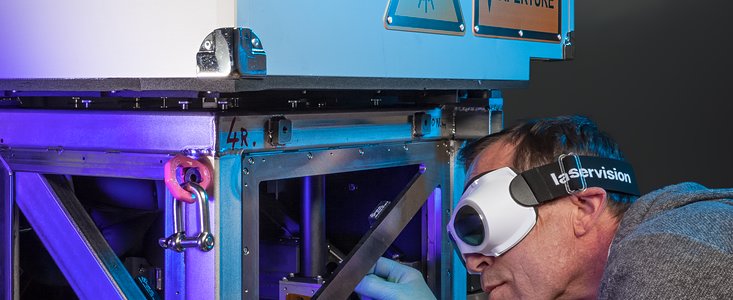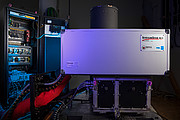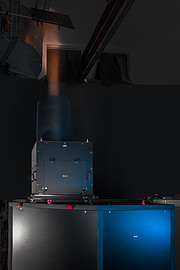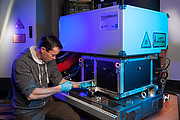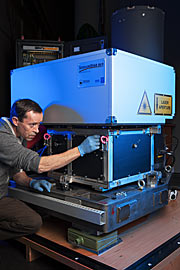Anúncio
Unidades de estrela guia laser aceites e enviadas para o Chile
Quatro estrelas guia laser passam teste crucial
27 de Novembro de 2015
As quatro unidades de estrela guia laser que formam a Instalação de Quatro Estrelas Guia Laser — uma parte crucial da Infraestrutura de Óptica Adaptativa do Very Large Telescope do ESO — acabam de ser aceites e enviadas para o Chile. Este é um enorme passo em frente na transformação do Telescópio Principal nº 4 do VLT num telescópio completamente adaptativo com uma qualidade de imagem altamente melhorada.
Os sistemas de óptica adaptativa usam sensores para analisar a turbulência atmosférica e um espelho deformável integrado no telescópio para corrigir as distorções da imagem causadas pela atmosfera. No entanto, é também indispensável existir uma fonte pontual brilhante no céu, muito próximo do objeto que está a ser observado, de maneira a que a turbulência possa ser caracterizada de modo preciso.
Encontrar uma estrela para este efeito no local certo do céu sem sempre é fácil. Por isso, para que a correção da turbulência atmosférica possa ser realizada em qualquer ponto do céu, para todos os possíveis alvos científicos, necessitamos de uma estrela artificial. Este tipo de “estrela” pode ser criada ao projetar um poderoso raio laser na camada de sódio da atmosfera, fazendo-a assim brilhar intensamente no que, observado a partir do solo, parece ser uma estrela.
Ao medir os movimentos e distorções induzidos atmosfericamente nesta estrela artificial e fazendo pequenos ajustes no espelho secundário deformável mil vezes por segundo, o telescópio consegue produzir imagens muito mais nítidas do que o que seria possível sem óptica adaptativa.
A primeira unidade de estrela guia laser da Infraestrutura de Óptica Adaptativa foi instalada no VLT e testada no local de modo bem sucedido em meados deste ano. Estes testes confirmaram o correto design implementado pelo ESO, em colaboração com a indústria europeia e instituições científicas [1]. Os testes realizados no Telescópio Principal nº 4 do VLT mostraram uma alta qualidade óptica, que forneceu uma imagem da estrela artificial quase perfeita e uma elevada eficiência na excitação da camada de sódio atmosférico. Estes resultados excelentes significam que a equipa pode avançar para testes preliminares com o GRAAL, o módulo de óptica adaptativa que alimenta o HAWK-I, a câmara de grande angular do Telescópio Principal nº 4; aproximando-nos assim a passos largos do total funcionamento da Infraestrutura de Óptica Adaptativa do Paranal.
A Infraestrutura de Óptica Adaptativa fará uso de quatro lasers em simultâneo, os quais possibilitarão uma melhor caracterização das propriedades da atmosfera — e portanto um maior campo de visão onde a imagem vai ser corrigida — do que o que seria possível com apenas um laser.
Quando estiver completamente instalada, a Infraestrutura de Óptica Adaptativa levará a luz a dois instrumentos, o HAWK-I (em conjugação com o GRAAL) e o espectrógrafo de campo integral MUSE (em conjunção com o GALACSI).
Notas
[1] As empresas envolvidas incluem: TOPTICA, Alemanha; TNO, Holanda; MPB Communications, Canadá; Optec, Itália; Astrel, Itália; e Laseroptik, Alemanha. Adicionalmente, o INAF–Osservatorio di Roma, em Itália, contribuiu também de forma significativa para o projeto.
Links
- Mais informações acerca do laser
- Mais informações acerca do espelho secundário deformável
- Mais informações acerca do telescópio de lançamento do laser
Contactos
Domenico Bonaccini Calia
ESO
Garching bei München, Alemanha
Tel: +49 89 3200 6567
Email: dbonacci@eso.org
Wolfgang Hackenberg
ESO
Garching bei München, Alemanha
Tel: +49 89 3200 6782
Email: whackenb@eso.org
Richard Hook
ESO, Public Information Officer
Garching bei München, Alemanha
Tel: +49 89 3200 6655
Telm: +49 151 1537 3591
Email: rhook@eso.org
Sobre o anúncio
| Id: | ann15089 |
Our use of Cookies
We use cookies that are essential for accessing our websites and using our services. We also use cookies to analyse, measure and improve our websites’ performance, to enable content sharing via social media and to display media content hosted on third-party platforms.
ESO Cookies Policy
The European Organisation for Astronomical Research in the Southern Hemisphere (ESO) is the pre-eminent intergovernmental science and technology organisation in astronomy. It carries out an ambitious programme focused on the design, construction and operation of powerful ground-based observing facilities for astronomy.
This Cookies Policy is intended to provide clarity by outlining the cookies used on the ESO public websites, their functions, the options you have for controlling them, and the ways you can contact us for additional details.
What are cookies?
Cookies are small pieces of data stored on your device by websites you visit. They serve various purposes, such as remembering login credentials and preferences and enhance your browsing experience.
Categories of cookies we use
Essential cookies (always active): These cookies are strictly necessary for the proper functioning of our website. Without these cookies, the website cannot operate correctly, and certain services, such as logging in or accessing secure areas, may not be available; because they are essential for the website’s operation, they cannot be disabled.
Functional Cookies: These cookies enhance your browsing experience by enabling additional features and personalization, such as remembering your preferences and settings. While not strictly necessary for the website to function, they improve usability and convenience; these cookies are only placed if you provide your consent.
Analytics cookies: These cookies collect information about how visitors interact with our website, such as which pages are visited most often and how users navigate the site. This data helps us improve website performance, optimize content, and enhance the user experience; these cookies are only placed if you provide your consent. We use the following analytics cookies.
Matomo Cookies:
This website uses Matomo (formerly Piwik), an open source software which enables the statistical analysis of website visits. Matomo uses cookies (text files) which are saved on your computer and which allow us to analyze how you use our website. The website user information generated by the cookies will only be saved on the servers of our IT Department. We use this information to analyze www.eso.org visits and to prepare reports on website activities. These data will not be disclosed to third parties.
On behalf of ESO, Matomo will use this information for the purpose of evaluating your use of the website, compiling reports on website activity and providing other services relating to website activity and internet usage.
Matomo cookies settings:
Additional Third-party cookies on ESO websites: some of our pages display content from external providers, e.g. YouTube.
Such third-party services are outside of ESO control and may, at any time, change their terms of service, use of cookies, etc.
YouTube: Some videos on the ESO website are embedded from ESO’s official YouTube channel. We have enabled YouTube’s privacy-enhanced mode, meaning that no cookies are set unless the user actively clicks on the video to play it. Additionally, in this mode, YouTube does not store any personally identifiable cookie data for embedded video playbacks. For more details, please refer to YouTube’s embedding videos information page.
Cookies can also be classified based on the following elements.
Regarding the domain, there are:
- First-party cookies, set by the website you are currently visiting. They are stored by the same domain that you are browsing and are used to enhance your experience on that site;
- Third-party cookies, set by a domain other than the one you are currently visiting.
As for their duration, cookies can be:
- Browser-session cookies, which are deleted when the user closes the browser;
- Stored cookies, which stay on the user's device for a predetermined period of time.
How to manage cookies
Cookie settings: You can modify your cookie choices for the ESO webpages at any time by clicking on the link Cookie settings at the bottom of any page.
In your browser: If you wish to delete cookies or instruct your browser to delete or block cookies by default, please visit the help pages of your browser:
Please be aware that if you delete or decline cookies, certain functionalities of our website may be not be available and your browsing experience may be affected.
You can set most browsers to prevent any cookies being placed on your device, but you may then have to manually adjust some preferences every time you visit a site/page. And some services and functionalities may not work properly at all (e.g. profile logging-in, shop check out).
Updates to the ESO Cookies Policy
The ESO Cookies Policy may be subject to future updates, which will be made available on this page.
Additional information
For any queries related to cookies, please contact: pdprATesoDOTorg.
As ESO public webpages are managed by our Department of Communication, your questions will be dealt with the support of the said Department.
